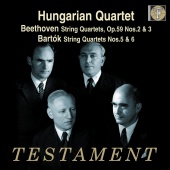| Label: Testament
Catalog: SBT1461
Format: CD Hungarian Quartet: Zoltán Székely & Alexandre Moskowsky, violins; Dénes Koromzay, viola; Vilmos Palotai, celloDisc 1
Ludwig van Beethoven (1770-1827)
String Quartet No.8 in E minor, Op.59 No.2
Bela Bartók (1881-1945)
String Quartet No.5 in B flat major
Disc 2
Bela Bartók
String Quartet No.6 in D
Ludwig van Beethoven
String Quartet No.9 in C, Op.59 No.3
Wholenote Discoveries - April 2011
The Hungarian Quartet recorded two complete Beethoven cycles for EMI, in 1953 and in 1966 with a change of second violin and cello. Testament has issued a 2 CD package containing two Beethoven Quartets, the op.59 nos.2 & 3 and two Bartok Quartets, nos.5 & 6 at a reduced price. They were recorded on two consecutive evenings, July 6 & 7 1955 in the Freemasons’ Hall in Edinburgh. The personnel is as in the 1953 cycle. These are exciting performances, excelling their studio versions of all four quartets. The sound is clear with some audience fussing here and there and the recording is missing deep bass. Otherwise, it’s a winner. Bruce Surtees
The title Hungarian Quartet was borne by two great Budapest string ensembles in the first three quarters of the last century. The first, led by Imre Waldbauer, was formed in 1910 to play the chamber music of Béla Bartók, Zoltán Kodály and Leó Weiner - the trio of composers who, in addition to the slightly older Erno" Dohnányi, were to carry the flags of Hungarian music and musical education for several decades. The Hungarian Quartet toured within Europe and its members - who included the violinist János Temesváry and the cellist Jeno" Kerpely as well as several first-rate violists - were very influential. Sadly, no records were made of the ensemble.
In 1935 a New Hungarian Quartet was formed by violinists Sándor Végh and Peter Szervánsky, violist Dénes Koromzay and cellist Vilmos Palotai. Owing to clashes between the violinists, Szervánsky was soon replaced by László Halmos. The young men made a start on a classical repertoire but specialised in new music by the likes of the Pole Jerzy Fitelberg, the Englishman Alan Bush the Frenchman André Jolivet and the Swiss Wladimir Vogel, as well as young Hungarian composers from Kodály's class such as Sándor Veress. One evening in 1935 Koromzay visited his old teacher Waldbauer with his friend the composer Pál Kadosa to play bridge. 'When I entered his living room I saw that there on the piano lay a new Bartók manuscript,' Koromzay reminisced to the cellist and writer Claude Kennison. It was the Fifth Quartet, which Waldbauer and his colleagues had to learn so as to give the first Hungarian performance. Koromzay asked to borrow the score for a few days and next morning appeared with it at his quartet's rehearsal. Their composer friends Kadosa and Veress offered to copy the score and the quartet members wrote out their individual parts from this copy. Koromzay then returned the original to Waldbauer without comment. Having worked furiously on the piece for three or four weeks, the New Hungarian Quartet offered to play it for Bartók. He decided to coach them in it and after ten days, offered them the first Budapest performance. This piece of skulduggery set the young ensemble on their road to success, as the Fifth Quartet became their calling card and they gave the first Vienna performance on 18 February 1936. The New Hungarians also persuaded the ISCM to accept the Bartók work for the 1936 festival in Barcelona, a further stepping stone in their international career.
Extract from the booklet note Tully Potter, 2010 |
 Price: $31.98
Price: $31.98











